Effect of Jet Nozzle Position on Mixing Time in Large Tanks
Abstract
1. Introduction
1.1. Mixing Time
1.1.1. Circulation Model
1.1.2. Jet Turbulence Model
2. Materials and Methods
2.1. Experimental Setup and Operating Conditions
2.2. Mixing Time Measurements
3. Results and Discussion
3.1. Comparison of Experimental Mixing Time with Different Models
3.2. Correlating Experimental Data Using Jet Turbulent Model
3.3. Correlating Experimental Data Using the Circulation Model
3.4. Impact of the Horizontal Position of the Jet Nozzle
3.5. Impact of the Vertical Inclination of the Nozzle
3.6. Impact of the Free Jet Path Length on Mixing Time
3.7. Impact of the jet Nozzle Diameter and Jet Inlet Velocity on Mixing Time
3.8. Correlation of Mixing Time with Power Input and Flow Momentum
4. Conclusions
Author Contributions
Funding
Data Availability Statement
Acknowledgments
Conflicts of Interest
Nomenclature
| Ci | Initial concentration (Moldm−3) |
| Final concentration (Moldm−3) | |
| dj | Jet nozzle diameter (m) |
| dz | Jet spread diameter at z (m) |
| f | Frequency (s−1) |
| Fr | Froude number Fr |
| G | Jet flow momentum (N) |
| g | Gravitational force (m/s2) |
| H | Liquid height (m) |
| hN | Nozzle clearance from tank bottom (m) |
| ho | Outlet clearance from tank bottom (m) |
| k | Entrainment rate model constant |
| L | integral scale of concentration fluctuations (m) |
| Pj | Jet power per unit volume (Watts/kg) |
| Q | Jet nozzle discharge flow rate (m3/s) |
| QE(zmax) | Jet entrainment rate within the jet spread across the free jet path length (m3/s) |
| QT | Total volumetric flow rate of the bulk volume (m3/s) |
| Rej | Jet fluid Reynolds number Rej |
| tm | Mixing time (s) |
| tc | Mean circulation time due to entrainment within the jet spread around zmax (s) |
| tR | Bulk fluid residence time (s) |
| t95 | 95% mixing time (s) |
| T | Tank diameter (m) |
| uj | Jet inlet velocity (m/s) |
| uz | Jet velocity at z (m/s) |
| V | Bulk fluid volume (m3) |
| XN | Jet nozzle clearance from the side wall (m) |
| z | Distance from the nozzle in the axis of the jet (m) |
| zmax | Free jet path length as the jet impinges on the liquid surface, side tank wall, or tank bottom (m) |
| Greek Symbols | |
| εj | Turbulent energy dissipation rate at the jet inlet (m2/s3) |
| Turbulent energy dissipation rate at (m2/s3) | |
| Density (kg/m3) | |
| µ | Viscosity (Pa·s) |
| α | Jet nozzle vertical inclination (°) |
| αuL | Jet nozzle vertical inclination upper limit (°) |
| αLL | Jet nozzle vertical inclination lower limit (°) |
| β | Jet nozzle horizontal position (°) |
| δ | Fox and Gex correlation constant |
| φ | Circulation model constant |
References
- Wasewar, K.L.; Sarathi, J.V. CFD Modelling and Simulation of Jet Mixed Tanks. Eng. Appl. Comput. Fluid Mech. 2008, 2, 155–171. [Google Scholar] [CrossRef]
- Randive, P.S.; Singh, D.D.P.; Varghese, D.V.; Badar, D.A.M. Study of Jet Mixing in Flocculation Process. Int. J. Multidiscip. Res. 2018, 6, 10. [Google Scholar]
- Wasewar, K.L. A Design of Jet Mixed Tank. Chem. Biochem. Eng. Q. 2006, 20, 31–45. [Google Scholar]
- Patwardhan, A.W.; Thatte, A.R. Process Design Aspects of Jet Mixers. Can. J. Chem. Eng. 2008, 82, 198–205. [Google Scholar] [CrossRef]
- Revill, B.K. Chapter 9—Jet mixing. In Mixing in the Process Industries; Harnby, N., Edwards, M.F., Nienow, A.W., Eds.; Butterworth-Heinemann: Oxford, UK, 1992; pp. 159–183. [Google Scholar]
- Abdel-Rahman, A. A Review of Effects of Initial and Boundary Conditions on Turbulent Jets. WSEAS Trans. Fluid Mech. 2010, 4, 257–275. [Google Scholar]
- Tilton, J.N. Perry’s Chemical Engineers’ Handbook: Fluid and Particle Dynamics; McGraw-Hill: New York, NY, USA, 2008. [Google Scholar]
- Fielder, H.E. Control of free turbulent shear flows. In Flow Control: Fundamentals and Practices; El-Hak, M.G., Pollard, A., Bonnet, J.P., Eds.; Springer: Berlin/Heidelberg, Germany, 1998; pp. 335–429. [Google Scholar]
- Rajaratnam, N. Turbulent mixing and diffusion of Jets. In Encyclopedia Fluid of Mechanics; Cheremisinoff, Ed.; Gulf Publishing: Houston, TX, USA, 1986; Volume 2, Chapter 15; pp. 391–404. [Google Scholar]
- Patwardhan, A.W.; Gaikwad, S.G. Mixing in Tanks Agitated by Jets. Chem. Eng. Res. Des. 2003, 81, 211–220. [Google Scholar] [CrossRef]
- Cabaret, F.; Rivera, C.; Fradette, L.; Heniche, M.; Tanguy, P.A. Hydrodynamics performance of a dual shaft mixer with viscous Newtonian liquids. Chem. Eng. Res. Des. 2007, 85, 583–590. [Google Scholar] [CrossRef]
- Fosset, H.; Mech, E.M.I. The action of free jets in mixing of fluids. Trans. Inst. Chem Eng. 1951, 29, 322. [Google Scholar]
- Fox, E.A.; Gex, V.E. Single-phase blending of liquids. AIChE J. 1956, 2, 539–544. [Google Scholar] [CrossRef]
- Okita, N.; Oyama, Y. Mixing Characteristics in Jet Mixing. Chem. Eng. 1963, 27, 252–260. [Google Scholar] [CrossRef]
- Rajaratnam, N. Turbulent Jets; Elsevier Scientific Publishing, Co.: Amsterdam, The Netherlands, 1976. [Google Scholar]
- Ricou, F.P.; Spalding, D.B. Measurements of entrainment by axisymmetrical turbulent jets. J. Fluid Mech. 1961, 11, 21–32. [Google Scholar] [CrossRef]
- Maruyama, T.; Ban, Y.; Mizushina, T. Jet mixing of fluids in tanks. J. Chem. Eng. Jpn. 1982, 15, 342–348. [Google Scholar] [CrossRef]
- Grenville, R.; Tilton, J.N. Turbulence for flow as a predictor of blend time in turbulent jet mixed vessels. In Proceedings of the Nineth European Conference on Mixing, Paris, France, 18–21 March 1997; pp. 67–74. [Google Scholar]
- Corrsin, S. The isotopic turbulent mixer: Part II Arbitrary Schmidt number. AIChE J. 1964, 10, 870–877. [Google Scholar] [CrossRef]
- Grenville, R.K.; Tilton, J.N. A new theory improves the correlation of blend time data from turbulent jet mixed vessels. Chem. Eng. Res. Des. 1996, 74, 390–396. [Google Scholar]
- Sotiriadis, T.; Firmansyah, T. Dawson Mixing of Sludges with Liquid Jets. J. Chart. Inst. Water Environ. Manag. 2006. preprint. [Google Scholar]
- Handbook of Industrial Mixing: Science and Practice; Paul, E.L., Atiemo-Obeng, V.A., Kresta, S.M., Eds.; Wiley-Interscience: Hoboken, NJ, USA, 2004. [Google Scholar]
- Perona, J.J.; Hylton, T.D.; Youngblood, E.L.; Cummins, R.L. Jet Mixing of Liquids in Long Horizontal Cylindrical Tanks. Ind. Eng. Chem. Res. 1998, 37, 1478–1482. [Google Scholar] [CrossRef]
- Grenville, R.K.; Tilton, J.N. Jet mixing in tall tanks: Comparison of methods for predicting blend times. Chem. Eng. Res. Des. 2011, 89, 2501–2506. [Google Scholar] [CrossRef]
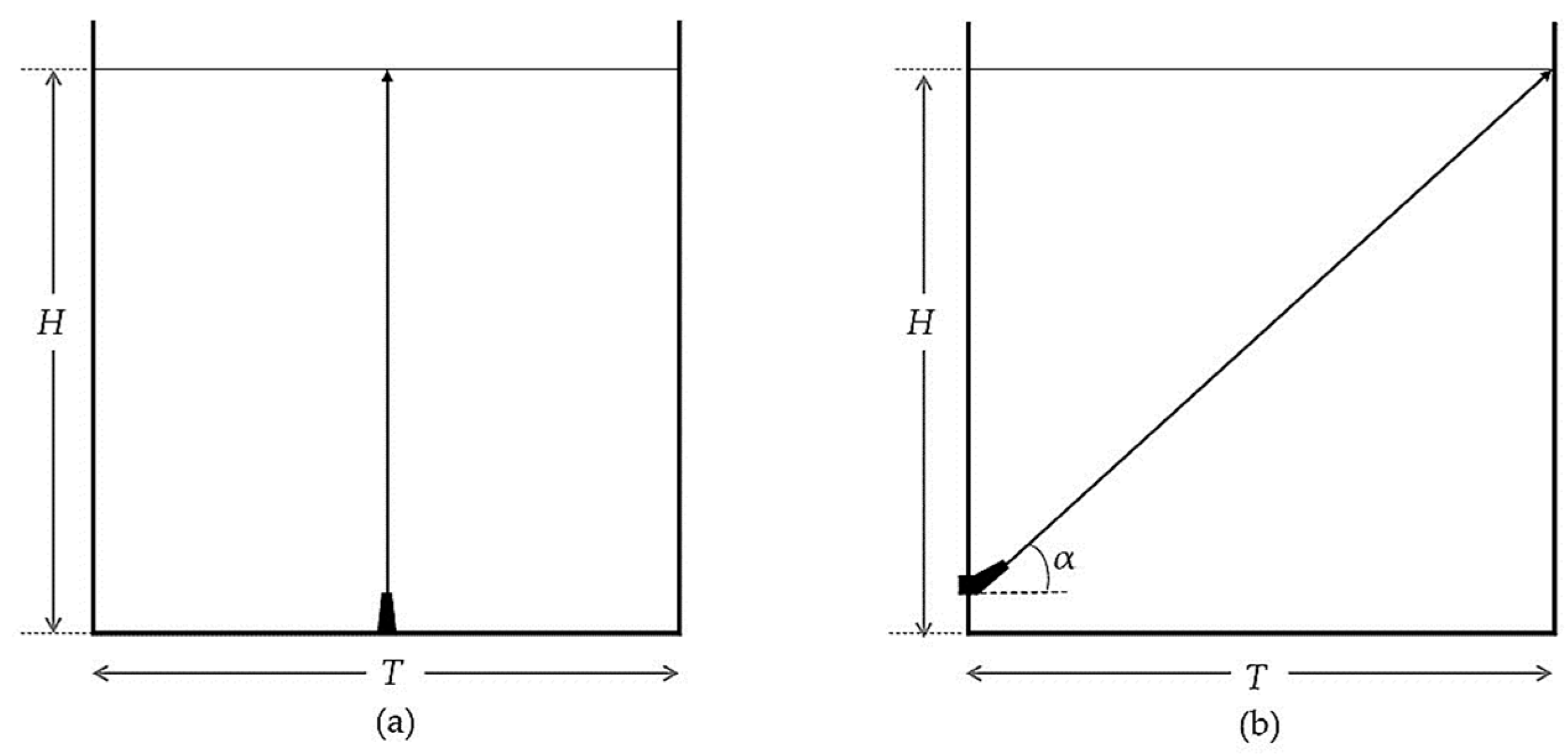
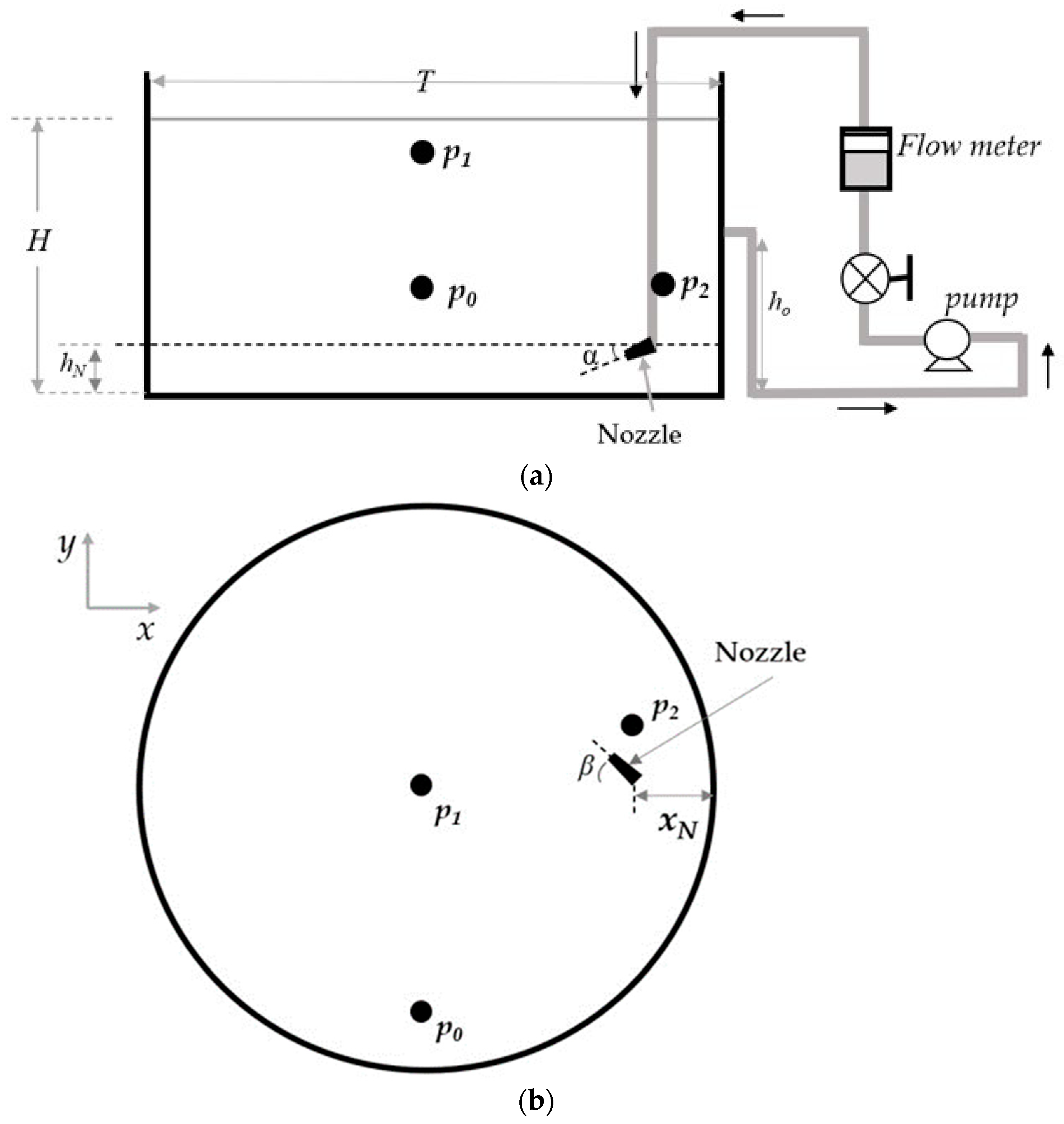

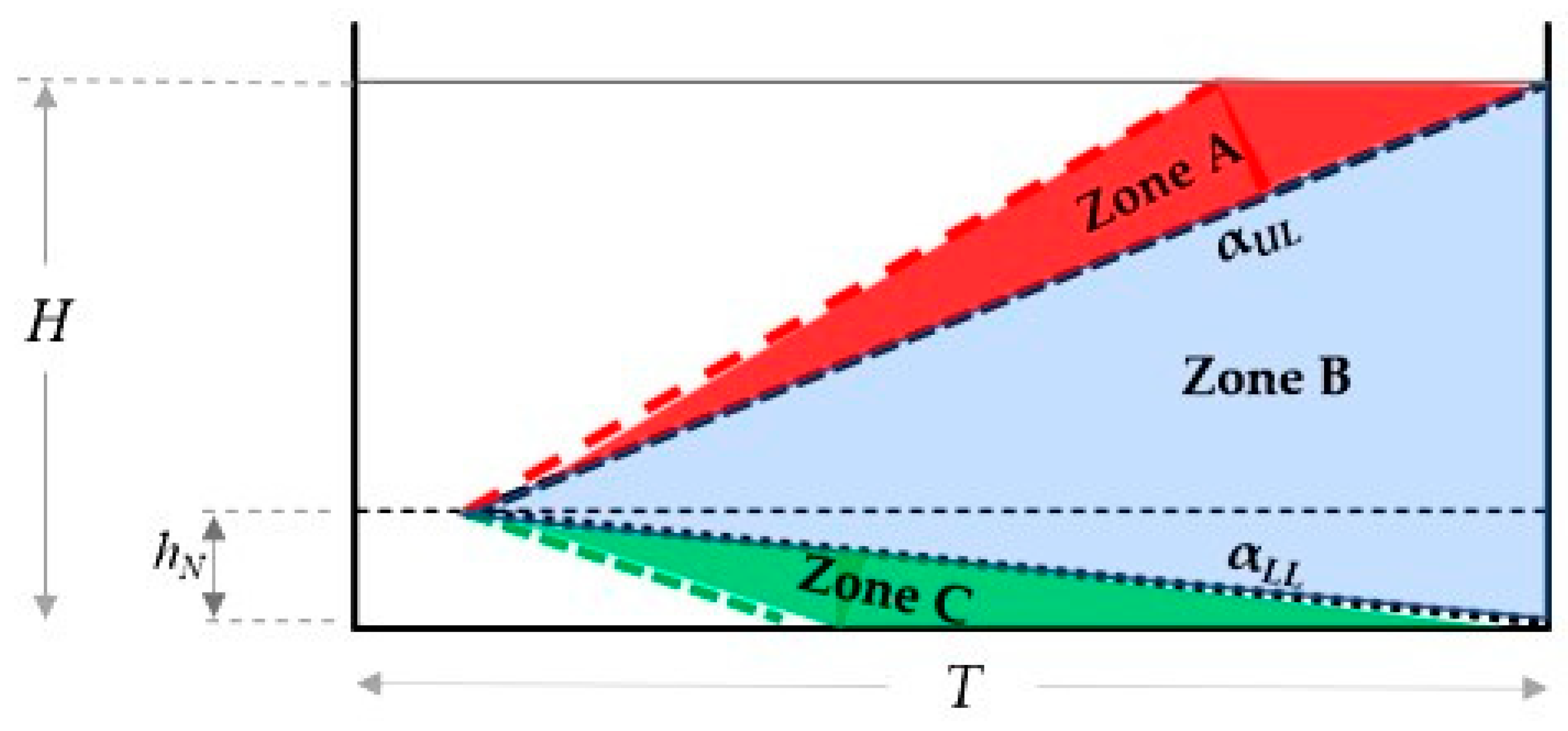
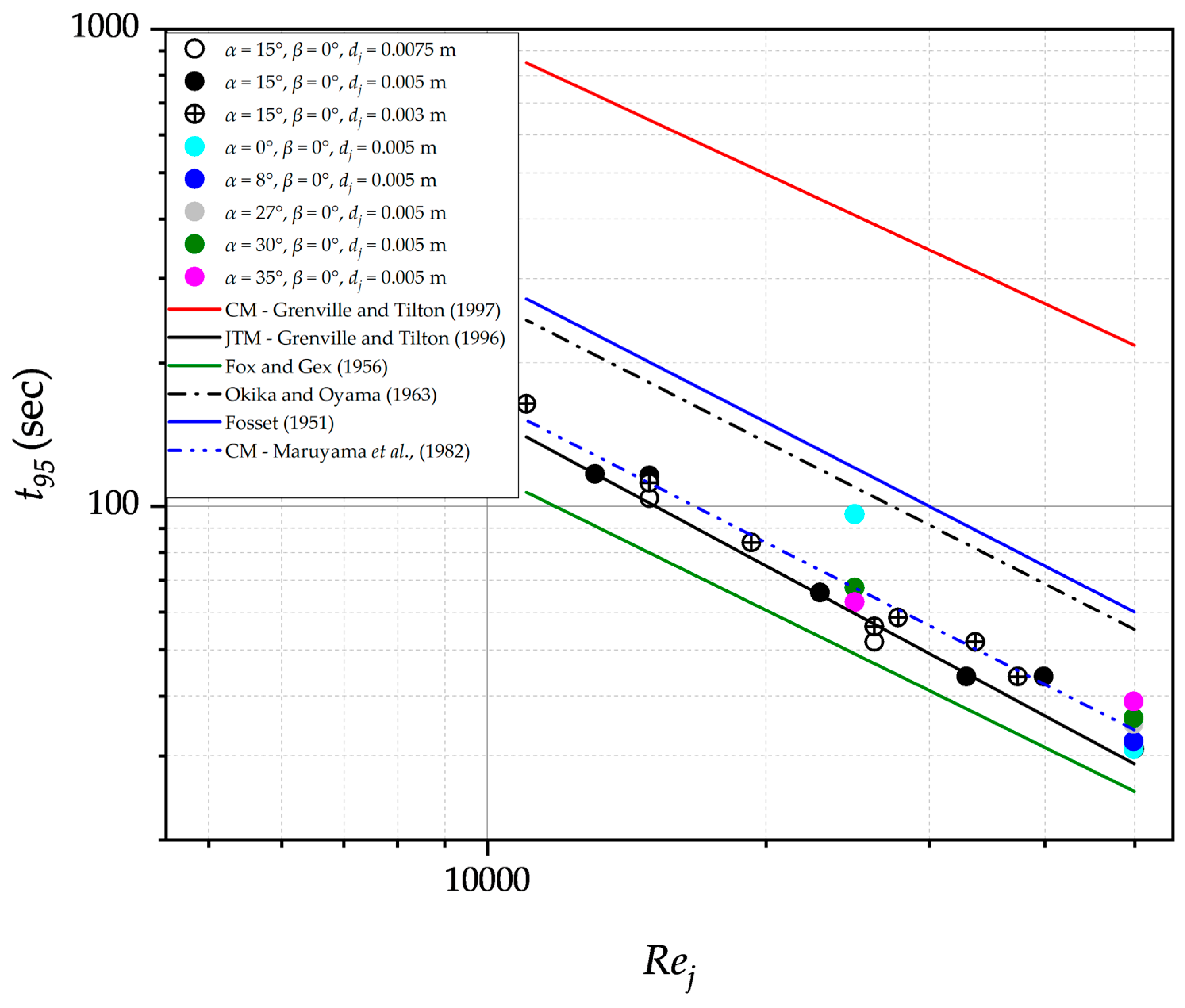
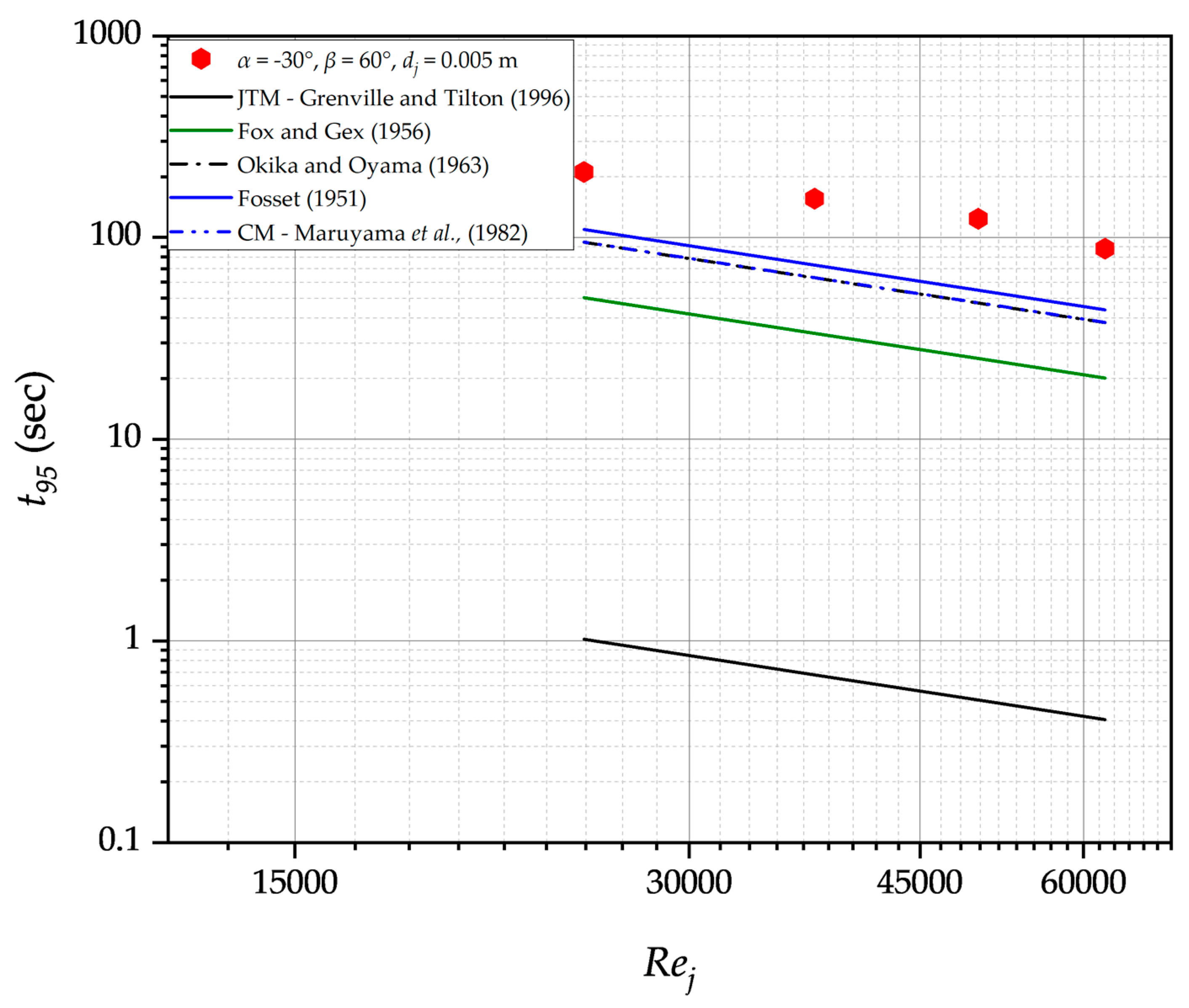
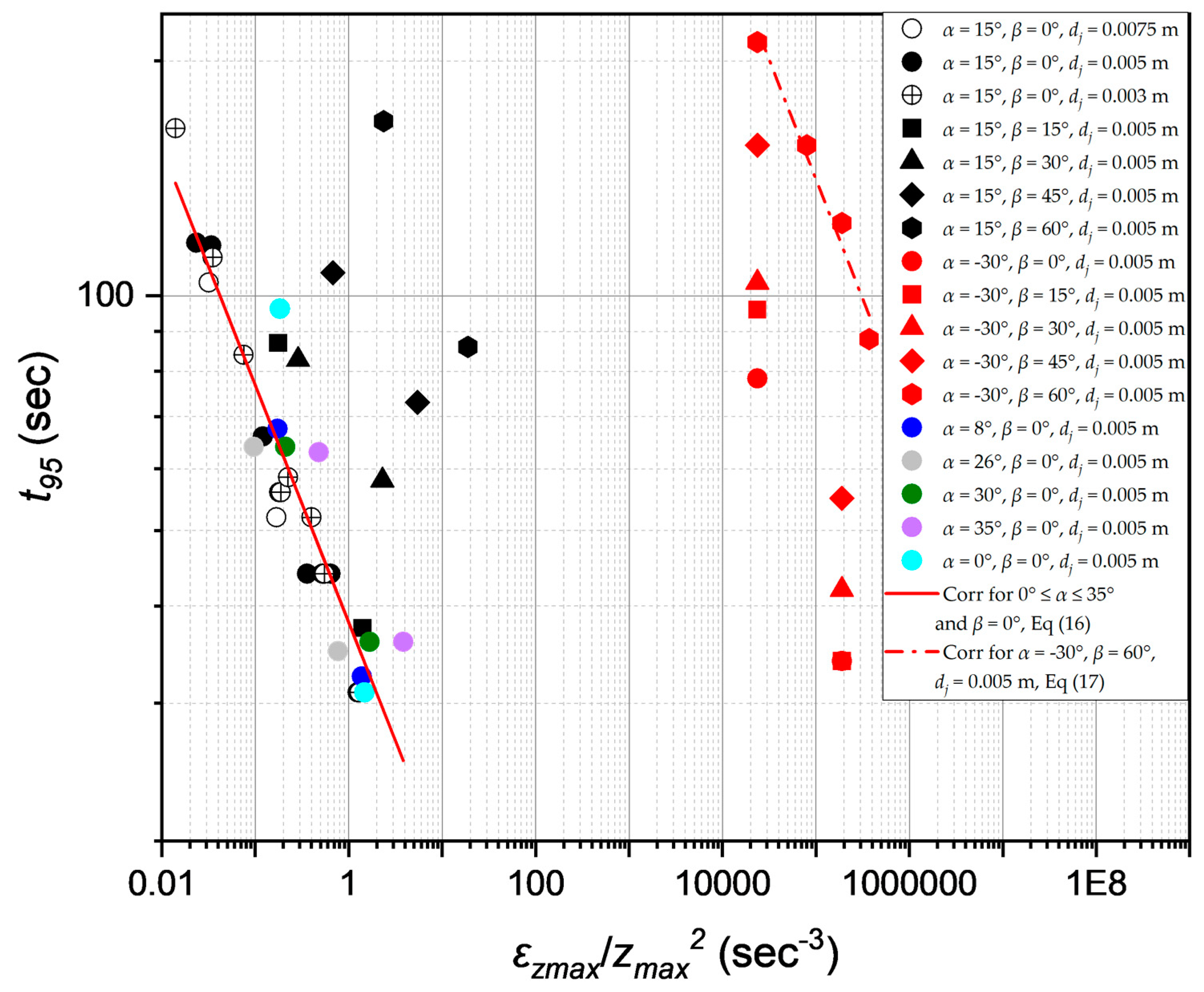


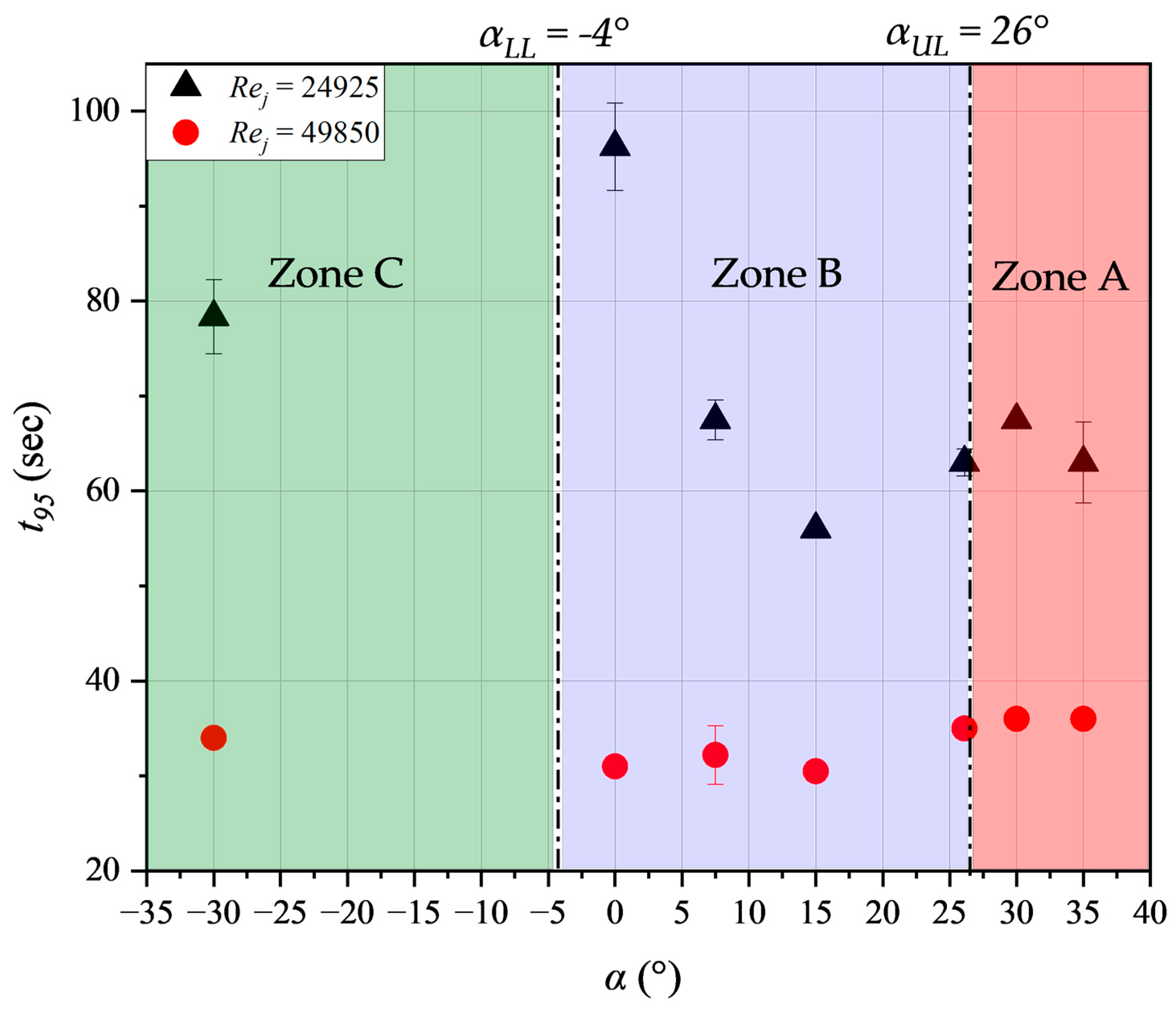

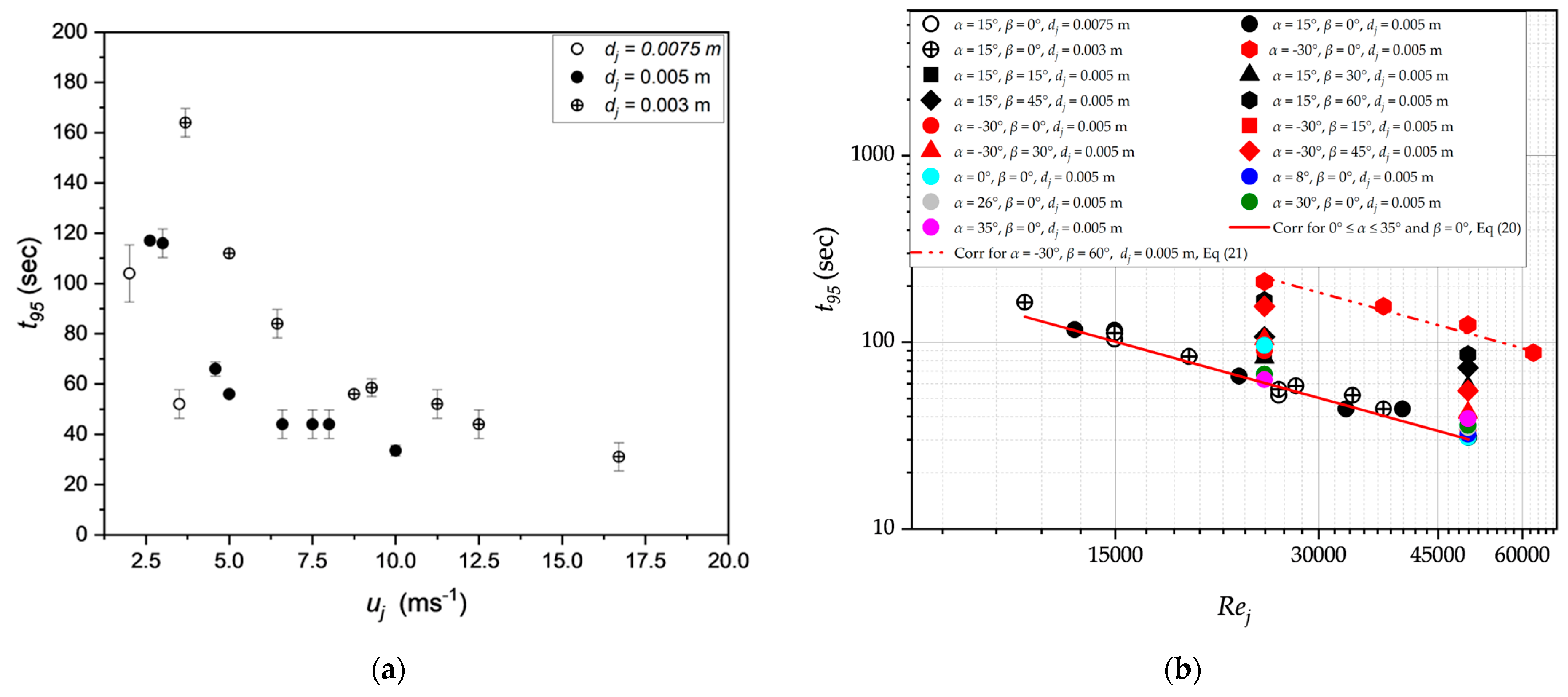
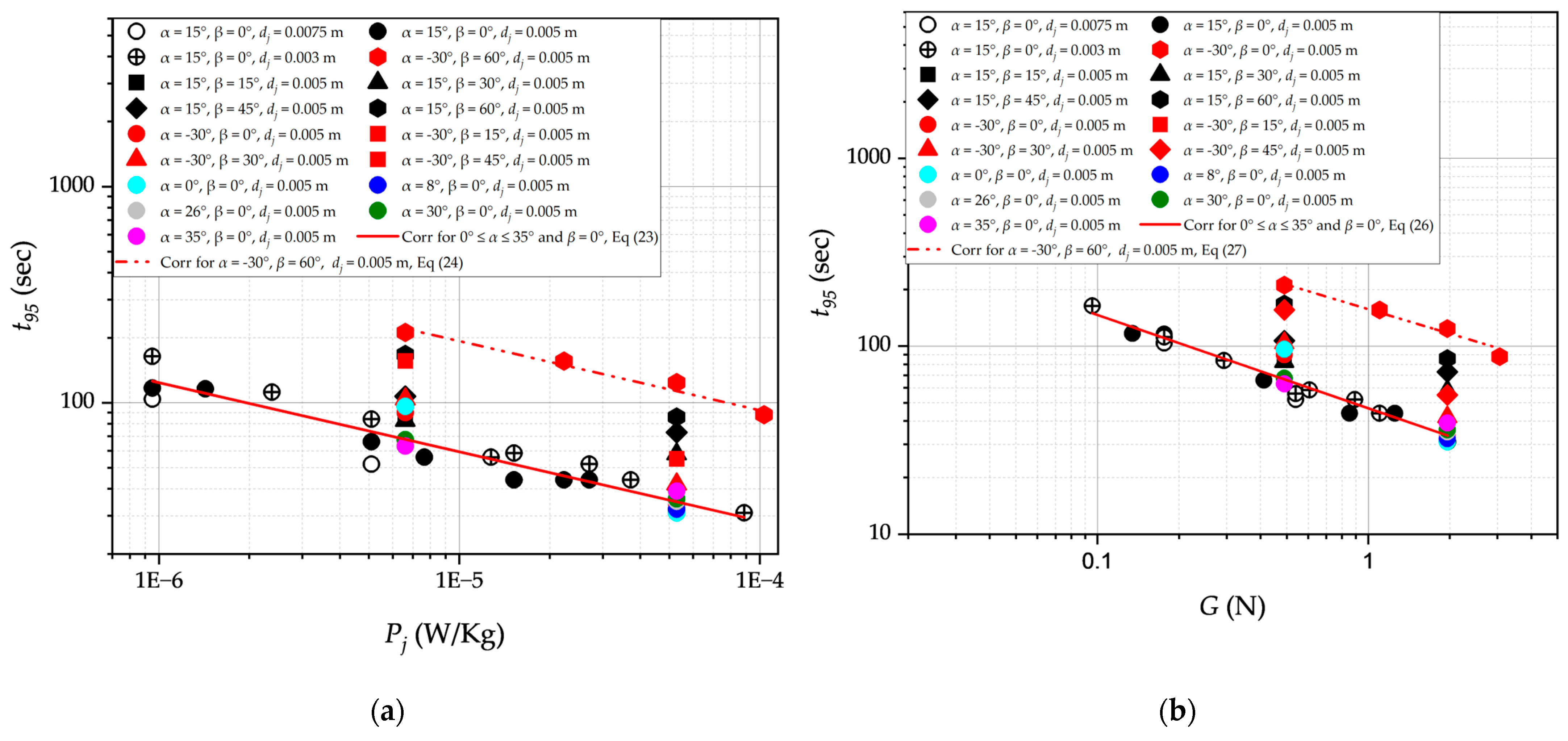
| Parameter | Symbol | Value (m) |
|---|---|---|
| Tank diameter | T | 0.780 |
| Liquid height | H | 0.390 |
| Nozzle diameter | dj | 0.003, 0.005, 0.0075 |
| Nozzle clearance from side wall | XN | 0.085 |
| Nozzle clearance from tank bottom | hN | 0.050 |
| Outlet clearance | hO | 0.192 |
| Vertical inclination of nozzle | α | |
| Horizontal inclination of nozzle | β | 0°, 15°, 30°, 45°, 60° |
| α (°) | β (°) | dj (m) | zmax (m) | |
|---|---|---|---|---|
| −30 | 0 | 0.005 | 0.093 | 0.32 |
| 15 | 0.005 | 0.093 | 0.31 | |
| 30 | 0.005 | 0.093 | 0.264 | |
| 45 | 0.005 | 0.093 | 0.193 | |
| 60 | 0.005 | 0.093 | 0.164 | |
| 15 | 0 | 0.0075 | 0.720 | 2.06 |
| 0 | 0.005 | 0.712 | 2.06 | |
| 0 | 0.003 | 0.707 | 2.06 | |
| 15 | 0.005 | 0.6930 | 2.06 | |
| 30 | 0.005 | 0.638 | 1.46 | |
| 45 | 0.005 | 0.552 | 1.10 | |
| 60 | 0.005 | 0.447 | 0.70 | |
| 0 | 0 | 0.005 | 0.688 | 1.88 |
| 8 | 0 | 0.005 | 0.694 | 1.61 |
| 26 | 0 | 0.005 | 0.766 | 1.22 * |
| 30 | 0 | 0.005 | 0.673 | 1.22 * |
| 35 | 0 | 0.005 | 0.585 | 1.22 * |
Disclaimer/Publisher’s Note: The statements, opinions and data contained in all publications are solely those of the individual author(s) and contributor(s) and not of MDPI and/or the editor(s). MDPI and/or the editor(s) disclaim responsibility for any injury to people or property resulting from any ideas, methods, instructions or products referred to in the content. |
© 2023 by the authors. Licensee MDPI, Basel, Switzerland. This article is an open access article distributed under the terms and conditions of the Creative Commons Attribution (CC BY) license (https://creativecommons.org/licenses/by/4.0/).
Share and Cite
Oluwadero, T.A.; Xuereb, C.; Aubin, J.; Poux, M. Effect of Jet Nozzle Position on Mixing Time in Large Tanks. Processes 2023, 11, 2200. https://doi.org/10.3390/pr11072200
Oluwadero TA, Xuereb C, Aubin J, Poux M. Effect of Jet Nozzle Position on Mixing Time in Large Tanks. Processes. 2023; 11(7):2200. https://doi.org/10.3390/pr11072200
Chicago/Turabian StyleOluwadero, Timothy Ayodeji, Catherine Xuereb, Joelle Aubin, and Martine Poux. 2023. "Effect of Jet Nozzle Position on Mixing Time in Large Tanks" Processes 11, no. 7: 2200. https://doi.org/10.3390/pr11072200
APA StyleOluwadero, T. A., Xuereb, C., Aubin, J., & Poux, M. (2023). Effect of Jet Nozzle Position on Mixing Time in Large Tanks. Processes, 11(7), 2200. https://doi.org/10.3390/pr11072200






